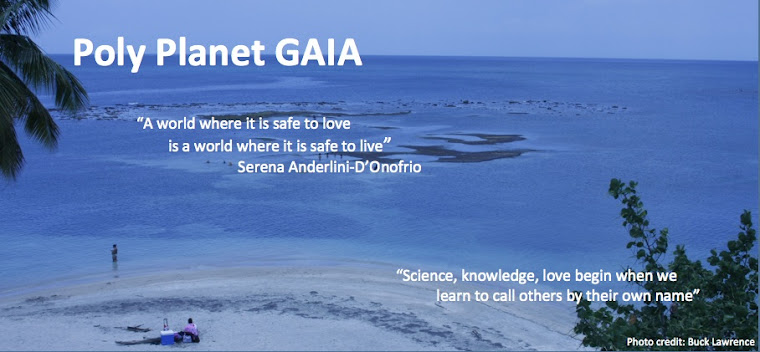Dear Earthlings:
The
EcoSex course at U Conn is complete. It was a great experience. We spent time reading amazing books. And here we resume posts to be shared with you. Thinking out of the box and across
disciplines. Students had been sending their responses in, with discussion
questions. In class, we did connected the dots: a
holograph of what we've read together, the "required readings."
Multiple perspectives and good synergy. Here, we offer a glimpse.
Lisa Diamond's Sexual Fluidity was one of two cultural-theory theory books. We got five responses: from Adam, Michael, Alissa, John, and Rhiann.
Here is Alissa's take:
Response to “Sexual Fluidity”
The concept of sexual fluidity
is not a concept I had been familiar with previously, but
the author explains
the topic in a convincing manner than exposes many unknown studies and ideas
that she has learned through her own longitudinal study. Lisa Diamond’s study I
find to be very interesting because society is so concerned with labels and
classifying people that people just assume sexuality is black and white, you
like men or you like women. Society has trouble accepting that a person may not
be sexually attracted to a specific gender or that they may be attracted to
both. I like how the author was able to include quotes and bios about the
various people in her study because it brought up scenarios that people would not
necessarily have thought of.
The
most important idea that I think this novel focuses on is the idea that each
person defines their sexual orientation differently and that sexual orientation
should not have parameters, but people should rather love who they love. Being
confined to a label conflicts people more often than not because they do not
feel that they are living up to what a true lesbian is or what a true
homosexual is. Sexual fluidity allows people to change who they are attracted
to and their orientation without having to put a label on their feelings. I
never made the distinction that those people who considered themselves bisexual
felt that it was not a right fit because it implied having an equal attraction
to men and women. The average person in society with minimal knowledge of
sexual orientation would think that bisexual, homosexual, heterosexual, and
even pansexual would cover all the areas. On the other hand, putting any label
on sexual orientation conflicts people for their circumstances may seem
abnormal and they would just prefer if they were not categorized with a
specific group.
A
subject area covered in the novel that was new to me was the idea that men’s
and women’s sexual identity can be separated further since they do not react in
a similar manner. For example the author talks about how women tend to have
more periods of fluidity throughout childhood and adulthood whereas men tend to
be more settled with an orientation later in life. Another piece that was odd
to me was how homosexual men and homosexual men would be sexually aroused by
respective attractions, but in the case of women they responded to all of the
videos that were displayed. This concept makes me believe that women are more
open to other types of attraction, while men to have more stability in their
orientation.
Why do you think the term
sexual fluidity applies more to women than men? Do you think this has to do
with the personalities and qualities that are stereotyped as masculine and
feminine?
Alissa Maus
Published with permission
WGSS 3998 - Ecosexuality and the Ecology of Love
Prof. Serena Anderlini-D'Onofrio
U Conn, Storrs, Spring 2013
Dear Earthlings:
Let "nature" be your teacher in the arts of love. Education is the heart of democracy, education to love. Come
back for more wonders: Students Responses have resumed, to appear now every Tuesday.
More Book Reports to be scheduled soon, every other Thursday.
Namaste,
Serena Anderlini-D'Onofrio, PhD
Gilf Gaia Extraordinaire
University of Puerto Rico, Mayaguez
Follow us in the social media
Website: www.serenagaia.com
Author's Page/Lists all books:
YouTube Uploaded Videos: http://www.youtube.com/













